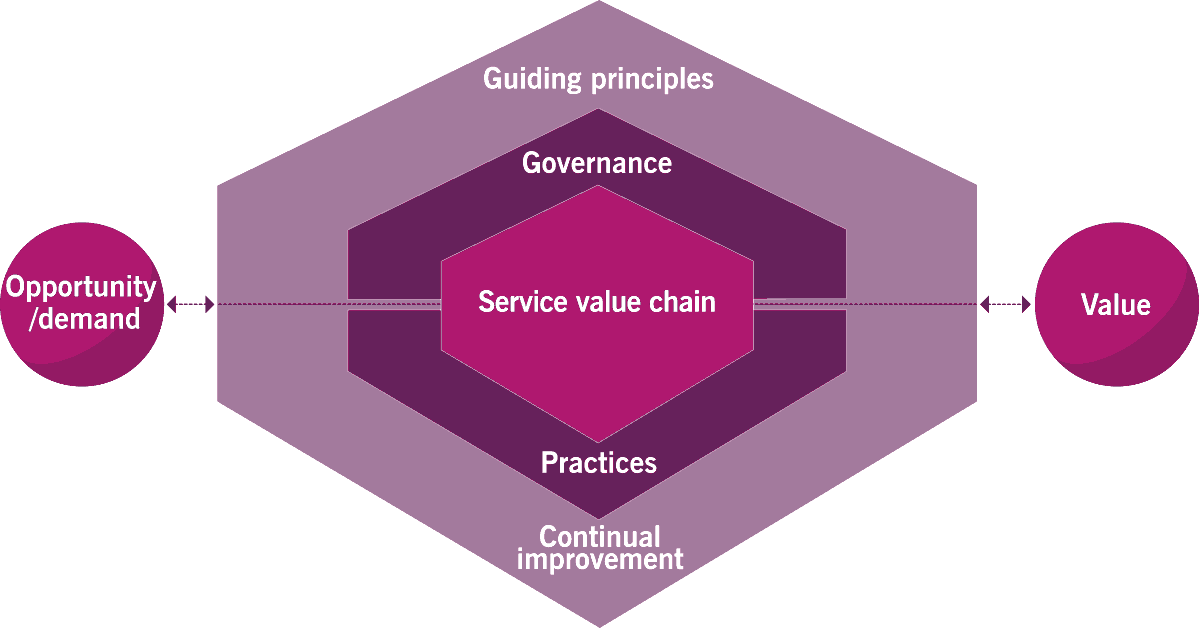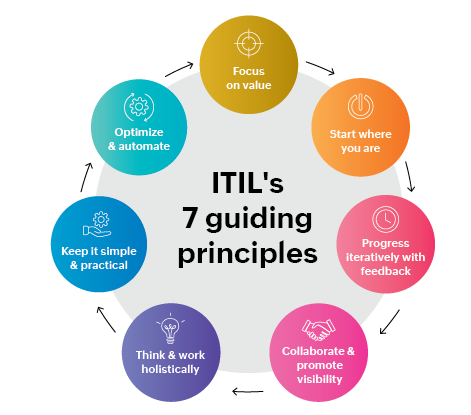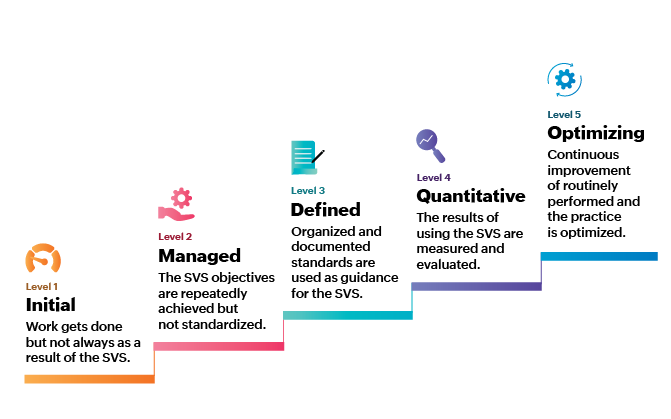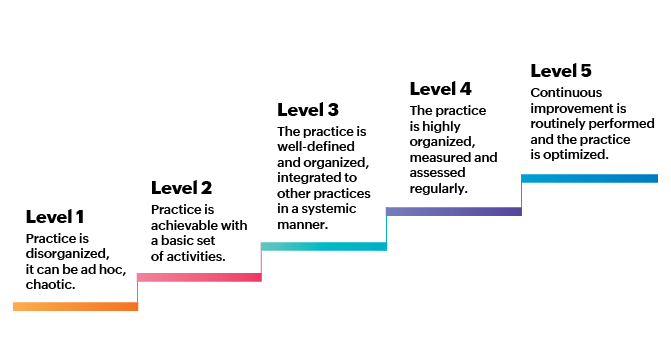Maturing Your ITIL Program for Consistency and Scalability
With 34 management practices, seven guiding principles, and a host of business-oriented concepts to grasp, adopting ITIL is an ambitious undertaking. The best way to approach it is to leverage those practices already in place and continuously improve until the organization reaches a level that suits its needs. The ITIL maturity model is designed to help organizations assess their current state and keep growing, creating value every step of the way. This article introduces ITIL, along with understanding how organizations of any size can use the ITIL maturity model to start small and grow a robust and effective best practice program.
Understanding ITIL
ITIL is a set of best practices for IT service management (ITSM) focused on delivering value through its seven guiding principles, 34 management practices, and models. Strategically, ITIL enables organizations to provide value by engaging with business stakeholders and aligning services with their needs. Since their inception in the 1980s, ITIL best practices have been adopted by organizations worldwide.
The concept of value is deeply embedded in the ITIL framework, wrapping governance models and best practices around its service value system, shown below.
The service value system uses a core set of ITIL concepts to support its service value chain. It starts with stakeholder engagement to define an opportunity or business demand for new/changed services and then produces value through activities that deliver that service. These activities are performed inside of ITIL governance practices, guiding principles, and a culture of continual improvement (aided by the ITIL maturity model).

ITIL Framework vs. ITIL Standards
ITIL is recognized as a framework rather than a standard. The ITIL framework provides a flexible model of management best practices and principles that organizations can adopt, adapt, and mature to meet their own organization's needs. The ITIL framework is often confused with a standard, which applies rigor to performing tasks more rigidly and controlled, leaving less flexibility.
Standards and Frameworks: Key Differences |
|
Standards |
Frameworks |
Standards offer guidelines, rules, and specific instructions established by a recognized body. |
Frameworks offer a set of practices and principles that form a conceptual structure that can be adapted to achieve a particular result. |
The purpose is to offer consistency and interoperability, offering the ability to measure or compare compliance against the standard. |
Unlike standards, framework use will vary by organization, and while adopting a framework can be mandated, the way it is adopted cannot be measured against a specific expectation. |
Standards can be mandated, and compliance can be measured, driving a specific quality level or technical consistency. |
|
Key ITIL Concepts
Value
ITIL helps providers create and operate services that provide value to the organization by working jointly with their business partners or stakeholders. ITIL defines this as the co-creation of value.
The Guiding Principles
The ITIL framework offers seven ITIL practices known as the guiding principles to ensure the practices adopted by the organization remain adaptable and straightforward. They provide an approach that can be adapted to an organization's needs and enable IT to deliver high-value services by operating efficiently and effectively.
These principles begin with a focus on value and an emphasis on starting with the current state. Starting where you are means assessing currently adopted best practices, determining which are effective, and then maturing the program iteratively until processes can be optimized and automated for simplicity.
The guiding principles and the ITIL maturity model form a foundation for any organization to start its ITIL adoption and keep growing, providing value throughout the process.

ITIL Management Practices
The ITIL framework defines 34 management practices to support service delivery organizations. These fall into three categories:
- Service management practices like incident, problem management, service catalog management, and configuration management enable the IT organization to deliver services effectively
- General service management best practices like portfolio management and organizational change management span both IT and the business units, working together on the creation of value
- Technical management practices to help with infrastructure and platform management and deploying new services.
These management practices leverage the ITIL process flows needed to ensure the outcomes of each practice are repeatable and can be continuously improved using the ITIL maturity model.
ITIL KPIs and Best Practices
As the ITIL framework aligns daily operations with the needs of the organization, key performance indicators (KPIs) provide a way of measuring success and form the basis for the ITIL maturity model.
Typical ITIL KPIs include operational and executive KPIs that indicate how well the organization meets business needs while revealing areas needing improvement and are based on critical success factors for the practice, which are documented as part of the ITIL maturity model (see Practice Success Factors).
The ITIL Maturity Model
The ITIL maturity model enables organizations to assess the current state of operations compared to a mature service value system. The resulting assessment allows them to "start where they are" and develop a roadmap of improvements that can be adopted over time using the guiding principles and ITIL KPIs as a foundation for continuous improvement.
Maturity levels have been defined for each area of the ITIL maturity model. They are used to document an organization's current state based on KPIs, documentation, and other evidence it can provide during a formal assessment.
Service Value System (SVS) Maturity:

When assessing the service value system, the maturity of each component shown below is evaluated against the maturity levels that have been defined for the SVS:
- Governance
- 7 Guiding principles
- Service value chain
- 34 Management Practices
- Continual improvement
Each of these components has a defined level of maturity. For example, governance maturity is based on the organization's ability to evaluate, direct, and monitor the management of strategy and portfolios. Maturity grows from executives monitoring the ad hoc performance of management activities to governance activities being systematically reviewed by a governing body against the organization's vision.
ITIL Practice Maturity (34 Management Practices)

The ITIL practice maturity model includes detailed assessment capabilities. For each of the 34 management capabilities or practices, five or six defined practice success factors (PSF) are required for the practice to fulfill its intended purpose or outcome. Each practice success factor has defined capability criteria mapped to the four dimensions of service management:
- People and Organizations
- Information and Technology
- Partners and Suppliers
- Value Streams and Processes
The ITIL maturity scale described previously is applied to each practice success factor and capability criteria, with the overall score for the practice determined by the lowest level achieved across all capabilities.1
For example, if some PSFs score a maturity level of two, others are at a three or four, the score for the practice is set at two.
When a practice is fully defined, generally at level four, the organization can seek to embed workflows in automation tools, making it easier to follow and enabling the organization to scale the practice.
Performing the Assessment and Creating the Roadmap
Organizations can begin their improvement journey by assessing the maturity and effectiveness of value co-creation using the components of the service value system and then diving more deeply into ITIL management practices.
Many organizations engage an outside party to perform their initial maturity assessment and frequently opt to perform periodic reviews internally. However, both can be done internally if an audit body with sufficient ITIL knowledge is available to perform them.
Once the assessment is conducted and results documented, the organization reviews the results for each component. It determines the short-term and longer-term maturity levels needed to achieve their desired strategic and operational outcomes, working with key business stakeholders to determine their needs.
These inputs are then used to create a roadmap for continual improvement, ensuring that IT services are aligned with business objectives and are delivered efficiently and effectively.
This assessment process can be performed in organizations that have not yet adopted ITIL based on best practices already in place, along with their business engagement and strategic practices. Doing so provides an analysis of where the organization is beginning its ITIL adoption journey.
The Business Value of the ITIL Maturity Model
The most significant value of the ITIL maturity model is that it enables organizations to use ITIL's 7 guiding principles to adopt ITIL gradually while continually assessing and improving until they reach their desired level of maturity.
This addresses a common complaint from organizations that feel it takes years to adopt ITIL and see any value it delivers. Using the ITIL maturity model, organizations can start small, see value, grow to the next level, see more value, and so forth. They can also collect feedback on the work being done and progress iteratively. As business needs change, the impact on best practices can be evaluated to see if adjustments are needed.
The ITIL maturity model provides a framework for establishing a shared vision and achieving it gradually, through many iterations, but without losing sight of the vision.
Finally, by helping organizations mature repetitive processes that make up their ITIL practices, the ITIL maturity model helps them automate their processes in service management tools, enabling scalability and consistency of operation.
1 For more information on the ITIL maturity definitions, see "An Overview of the ITIL® Maturity Model," provided by Axelos.

